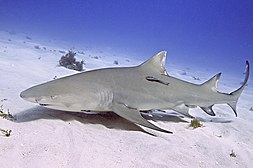
Back Carcharhinidae Afrikaans بنبكيات Arabic بنبكيات ARZ Karxarinlər Azerbaijani Шэрыя акулы Byelorussian Шэрыя акулы BE-X-OLD Сиви акули Bulgarian Carcarínids Catalan Carcharhinidae CEB Modrounovití Czech
| Requiem sharks Temporal range:
| |
|---|---|

| |
| Blacktip reef shark, Carcharhinus melanopterus | |
| Scientific classification | |
| Domain: | Eukaryota |
| Kingdom: | Animalia |
| Phylum: | Chordata |
| Class: | Chondrichthyes |
| Subclass: | Elasmobranchii |
| Subdivision: | Selachimorpha |
| Order: | Carcharhiniformes |
| Family: | Carcharhinidae D. S. Jordan & Evermann, 1896 |




Requiem sharks are sharks of the family Carcharhinidae in the order Carcharhiniformes. They are migratory, live-bearing sharks of warm seas (sometimes of brackish or fresh water) and include such species as the bull shark, lemon shark, spinner shark, blacknose shark, blacktip shark, grey reef shark, blacktip reef shark, silky shark, dusky shark, blue shark, copper shark, oceanic whitetip shark, and whitetip reef shark.
Family members have the usual carcharhiniform characteristics. Their eyes are round, and one or two gill slits fall over the pectoral fin base. Most species are viviparous, the young being born fully developed. They vary widely in size, from as small as 69 cm (2.26 ft) adult length in the Australian sharpnose shark, up to 4 m (13 ft) adult length in the oceanic whitetip shark.[1] Scientists assume that the size and shape of their pectoral fins have the right dimensions to minimize transport cost.[2] Requiem sharks tend to live in more tropical areas, but tend to migrate. Females release a chemical in the ocean in order to let the males know they are ready to mate. Typical mating time for these sharks is around spring to autumn.[3]
According to the ISAF, requiem sharks are among the top five species involved in shark attacks on humans;[4] However, it's important to note that "requiem shark" is not a single species, but refers, in this case, to a group of similar sharks that are involved in incidents. ISAF preferred to use "requiem sharks" due to the difficulty in identifying individual species.[5]
- ^ Compagno, L.J.V. Family Carcharhinidae - Requiem sharks in Froese, R. and D. Pauly. Editors. 2010. FishBase. World Wide Web electronic publication, version (10/2013).
- ^ Iosilevskii, G.; Papastamatiou, Y. P. (2016). "Relations between morphology, buoyancy and energetics of requiem sharks". Royal Society Open Science. 3 (10): 160406. Bibcode:2016RSOS....360406I. doi:10.1098/rsos.160406. PMC 5098981. PMID 27853556.
- ^ "Introducing Requiem Sharks". 22 August 2016.
- ^ "Species Implicated in Attacks". Florida Museum. 24 January 2018. Retrieved 2 June 2018.
- ^ ISAF Statistics on Attacking Species of Shark Archived July 24, 2009, at the Wayback Machine